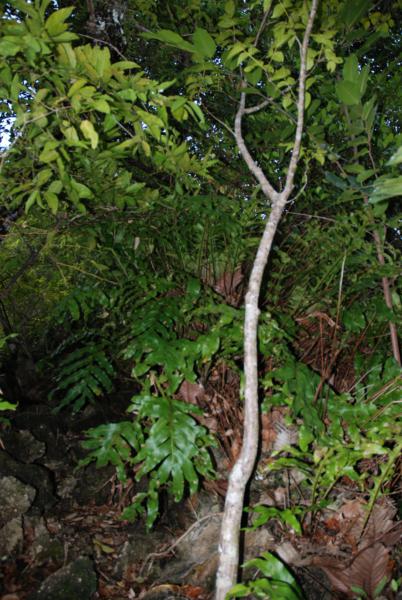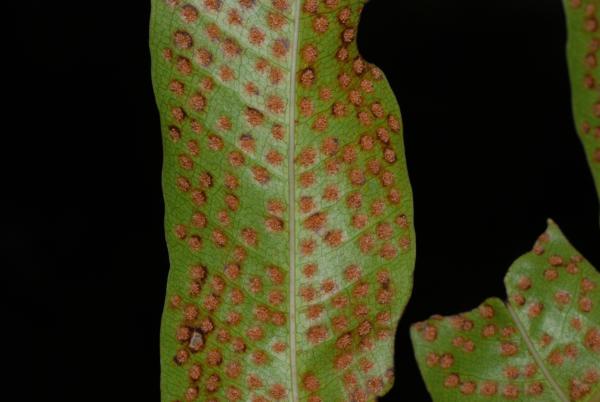
Drynaria quercifolia (L.) J.Sm.
Family
Polypodiaceae
Nomenclature
Drynaria quercifolia (L.) J.Sm., J. Bot. 3: 398. 1841; Bedd., Handb. Ferns Brit. India: 341, f. 191. 1883; E.Smith, J. Siam Soc. Nat. Hist. Suppl. 8: 6. 1929; C.Chr., Contr. U.S. Natl. Herb. 26: 335. 1931; Tardieu & C.Chr., Fl. Indo-Chine 7(2): 518. 1941; Holttum, Rev. Fl. Malaya ed. 1, 2: 182, f. 88. 1955 [‘1954’]; Holttum, Dansk Bot. Ark. 23: 231. 1965; Tagawa & K.Iwats., SouthE. Asian Stud. 3(3): 77. 1965; Tagawa & K.Iwats., SouthE. Asian Stud. 5: 59. 1967; Tagawa & K.Iwats., Fl. Thailand 3: 546. 1989; Hovenkamp & Roos, Fl. Males., Ser. II, Ferns and Fern Allies 3: 40. 1998; Boonkerd & Pollawatn, Pterid. Thailand: 269. 2000; Newman et al., Checkl. Vasc. Pl. Lao PDR: 29. 2007; Leti et al., Fl. Photogr. Cambodge 557. 2013. – Polypodium quercifolium L., Sp. Pl. 2: 1087. 1753. – Type: Herb. Hermann I: 39 (BM).
Description
Rhizome short creeping, 1–2 cm diam., densely scaly; scales dark brown, gradually narrowing from base to tailed apex, up to 4–18 mm long, 1.3 mm broad, the margin paler and densely toothed. Nest-leaves sessile, ovate, 15–32(–50) by 10–20(–40) cm, shallowly lobed; lobes close, 5 by 3 cm, rounded to moderately acute at apex, entire. Foliage-leaves: stipes 15–25(–35) cm long, stramineous, very narrowly winged throughout, densely scaly at base, these similar to the rhizome scales; laminae pinnatifid, oblong to narrower, 40–80(–150) by 15–50 cm, deeply pinnatifid, continuous to the next ones by rather broad wings more than 1 cm in breadth; lobes ascending, gradually narrowing from base to acute or acuminate apex, entire and more or less crisped at margin, 1–25(–30) by 2–4.5 cm; veins distinct on both surfaces, finely anastomosing with more than 10 rows of areoles between main veins; coriaceous, shining pale green, glabrous. Sori round or oblong, two rows between adjacent main veins.
Distribution in Thailand
NORTHERN: Chiang Mai, Chiang Rai, Tak, Phitsanulok; NORTH-EASTERN: Nong Khai; SOUTH-WESTERN: Kanchanaburi, Prachuap Khiri Khan; SOUTH EASTERN: Chon Buri, Chanthaburi, Trat; PENINSULAR: Phangnga, Surat Thani, Krabi, Nakhon Si Thammarat, Phuket, Phatthalung, Trang, Satun, Yala.
Distribution in Laos
Champasak, Xieng Khouang.
Distribution in Cambodia
Mondulkiri, Siem Reap.
Wider Distribution
Sri Lanka, India to S China and Indochina, throughout Malesia to Fiji and tropical Australia.
Ecology
On rather dry rocks on hillsides in light shade or at edge of forests, fairly common at low altitudes.
Proposed IUCN Conservation Assessment
Least Concern (LC). This species is widespread and not under any known threat.
Voucher specimens - Thailand
Middleton et al. 4450, Krabi, Ko Phi Phi National Park (E).
Voucher specimens - Laos
Maxwell 97-1134, Champasak (CMU)
Voucher specimens - Cambodia
Long et al. CL342, Mondulkiri (P).
Habit
Sori
Site hosted by the Royal Botanic Garden Edinburgh. Content managed by Stuart Lindsay, Gardens by the Bay, Singapore and David Middleton, Singapore Botanic Gardens. Last updated 24 January 2012

